Raising a flag: The mistakes and struggles that made Utah’s state flags
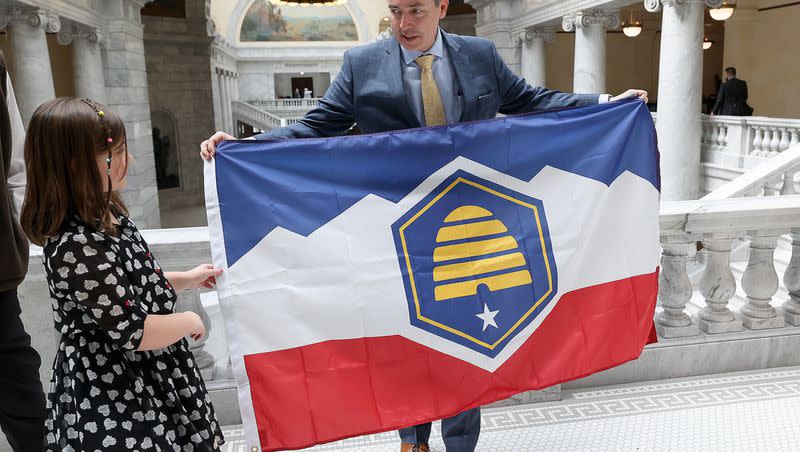
In 1896, Utah had just about everything it needed as a brand-new state. Governor? Check. State Constitution? Check. State Seal? Check.
A state flag? ... Well, no.
With all the hoopla in 2023 about getting a new state flag (including the recently failed effort to put the issue on November’s ballot), the state’s founders in 1896 were remarkably lax about getting Utah its own banner.
Related
Effort to send new Utah flag to statewide referendum fails, state says
Do Utahns like the new state flag? A poll says more do than don’t
The parade flag
It was eight years later, in 1903, when President Theodore Roosevelt, a friend of Utah, was scheduled to be at the St. Louis World’s Fair. The president would be honored by a parade planned to feature all the flags of America’s 45 states plus territories. Utah Gov. Heber M. Wells sensed that it wouldn’t look good for the nation’s newest state to march with an empty pole. Gov. Wells enlisted the help of the Utah State Society Daughters of the Revolution (not to be confused with Daughters of the American Revolution, which at the time didn’t admit Latter-day Saints).
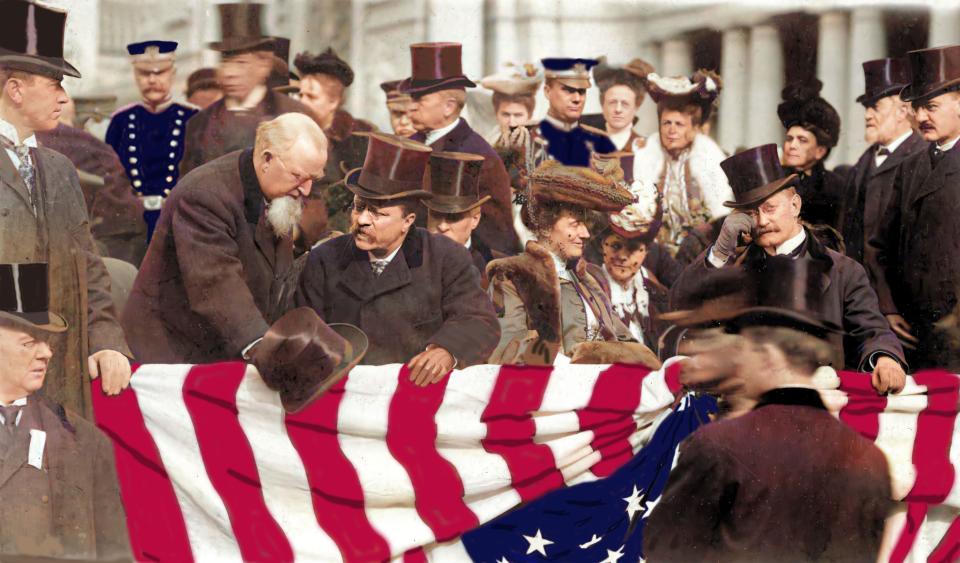
The Daughters of the Revolution raised the funds from their membership and hired a seamstress at Zion’s Co-operative Mercantile Institution. Agnes Teudt Ferneliu, to make the flag. With some design tweaks from famous Utah artist H.L.A. Culmer, they chose an embroidered white outline of the state seal on a blue background of Utah homespun and dyed silk.
Utah’s seal had been designed eight years earlier by Charles M. Jackson, a crime reporter for the Salt Lake Herald, an independent newspaper friendly to The Church of Jesus Christ of Latter-day Saints, and Harry Emmett Edwards, an artist and bartender. Their winning design’s main features included a beehive surrounded by bees and sego lilies (symbolizing pioneer industriousness and working together), a defiant American eagle (symbolizing liberty), six arrows (symbolizing Utah’s Native Americans), and American flags (symbolizing Utah’s strong urge to prove they were loyal patriots).
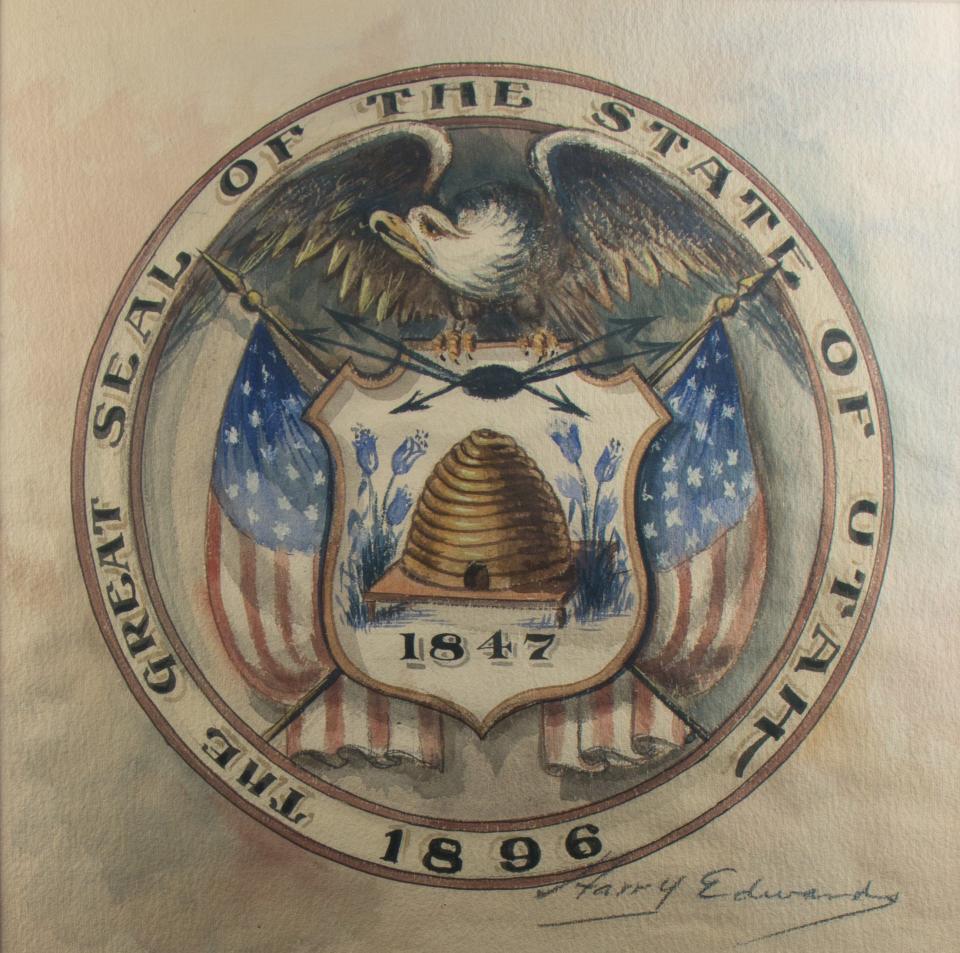
The 1903 flag with that seal was a success, but it never became Utah’s official state flag, even though it was often used like a state flag. Instead it was called the governor’s flag.
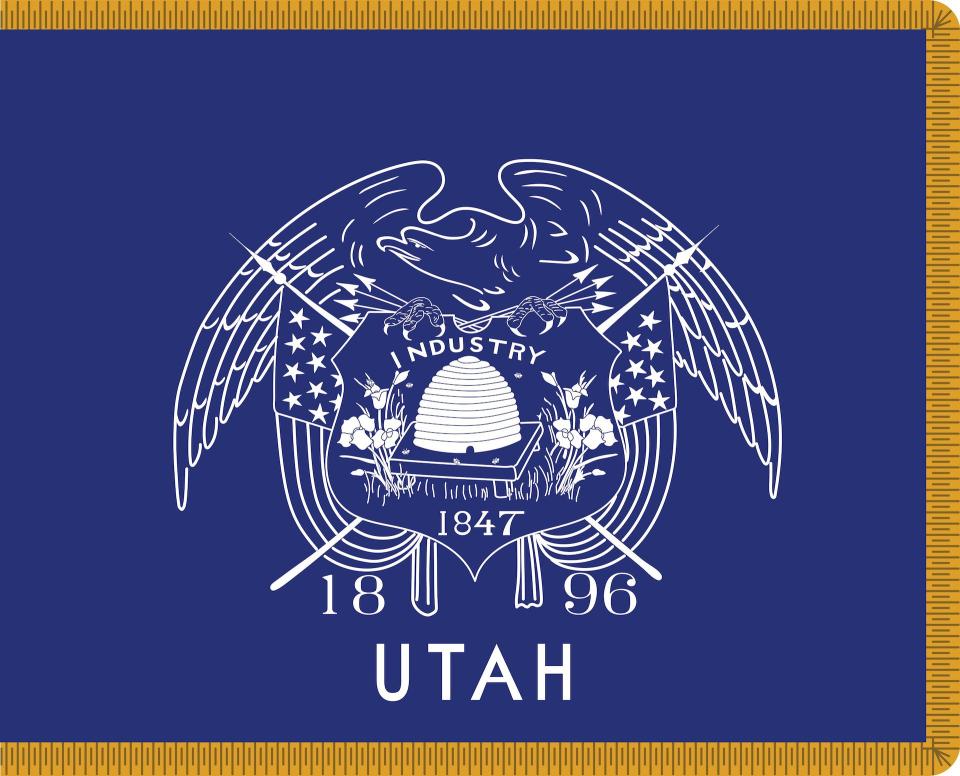
The first flag
If the embarrassment of not having an official state flag for a parade was not enough to get an official state flag, a bigger embarrassment pushed action nine years later in 1911. The United States Navy was going to launch a new battleship named after the state. The U.S.S. Utah needed a state flag to display in their ward room. The problem was, the 1903 “governor’s flag” wasn’t officially the state flag.
In short order, on March 9, 1911, Utah’s legislature passed Senate Joint Resolution No. 17, adopting Utah’s first state flag. The design was based upon the 1903 governor’s flag with a few minor changes, such as putting the word “Utah” above “1847” on the flag’s shield. The Daughters of Utah Pioneers (DUP) and the Sons of Utah Pioneers joined forces to fund the new Utah flag for the battleship. They ordered a presentation flag version, which was common at the time, featuring the names of their organizations on the flag below the seal. Fortunately, this version of Utah’s first official flag was never made.
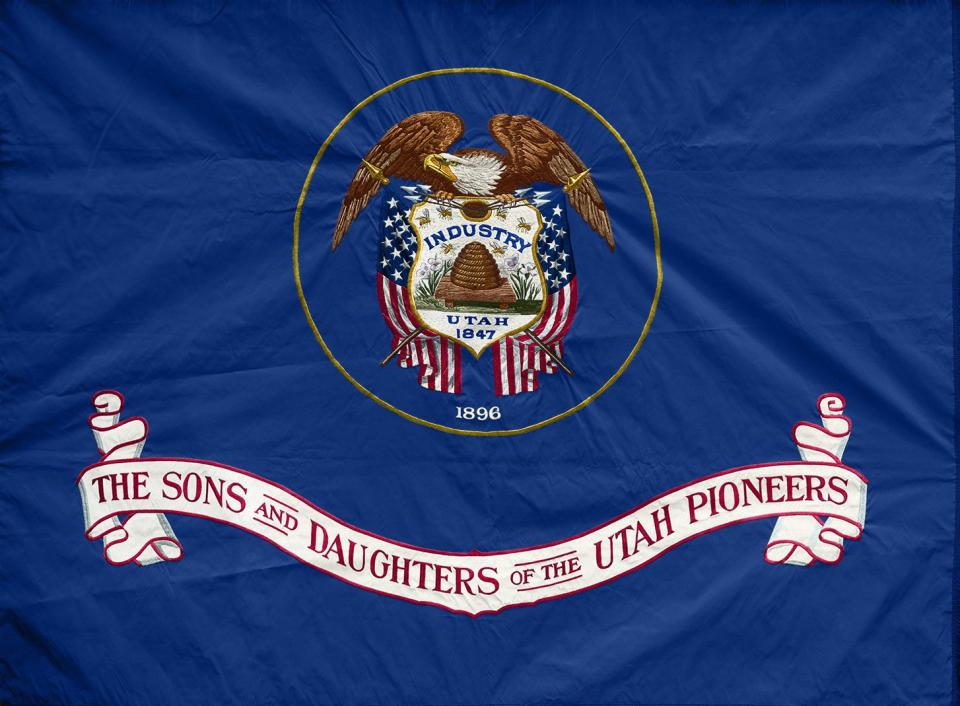
The great mistake flag
One can only imagine what the Wm. H. Horstmann company in Philadelphia thought when it examined Utah’s request to make a Utah flag for the battleship. Maybe the design of a white outline of a seal on a blue background was just a preliminary sketch. Or perhaps the design struck the company as too primitive. In any case, their expert embroiderers went to work, missing the deadlines for the U.S.S. Utah’s commission ceremony, but at last finishing the flag in early 1913.
When the flag finally arrived in Salt Lake City, it created a sensation. Instead of a seal outline in white, they received a stunningly detailed, full-color flag with a gold circle surrounding the seal. It was like they had ordered a Toyota Camry and received a Lamborghini.
The only problem was that because it didn’t follow the statute, it wasn’t really Utah’s flag. With no time to have a correct flag made, Rep. Annie Wells Cannon introduced a joint resolution to make the new color flag the official state flag. After rejecting a few ridiculous amendments proposed by the state senate (such as describing the arrowheads as “steel” and the beehive table as “dark stained oak”) the new color flag was made official, sent off to the battleship and was forgotten. This left Utah without a single state flag for another nine years.
The persistent mistake flag
In 1921, it was more than quarter century since Utah became a state, and it was still, basically, flagless. Only one flag existed, and it was at sea. This time a Utah flag was requested to be displayed in New York in a patriotic parade of states. The 1903 flag was around, but didn’t comply with the statute, so several groups said they would provide a flag. The Jewish Young Men’s Society of Salt Lake planned on making a flag but had a difficult time obtaining the right type of silk. The women’s auxiliary of the Grand Army of the Republic (a Civil War veterans organization) moved ahead, hiring seamstress Dolly McMonegal to sew the flag.
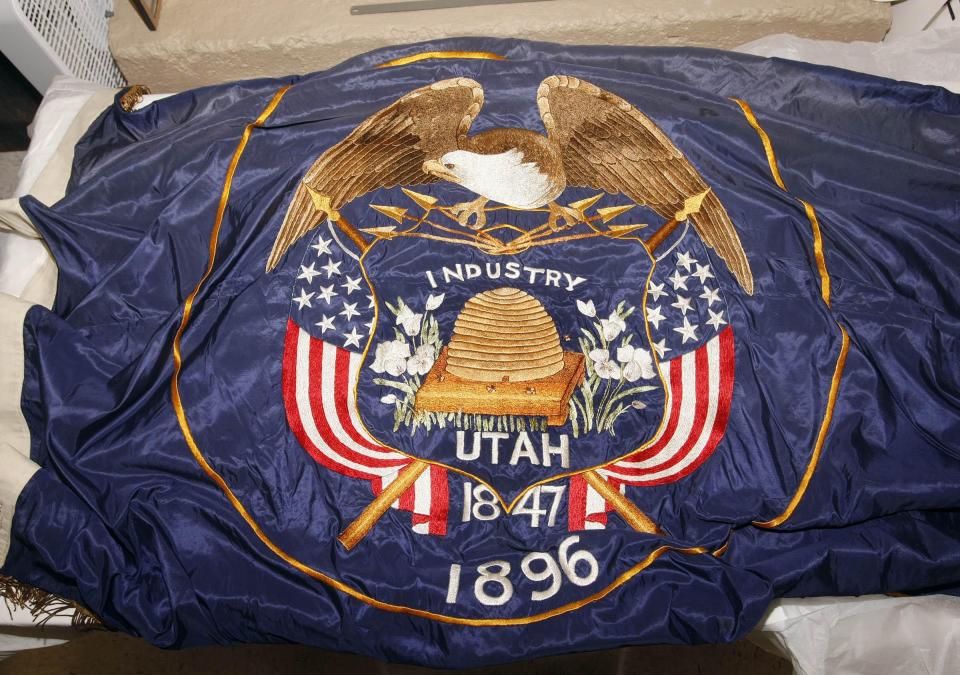
For decades, McMonegal has been blamed and mocked for “forgetting” to put “1847” on the shield as specified by state statute. The truth is she carefully followed Title 35, Section 2664, of the 1917 Compiled Laws of Utah. That copy of the law had a typographical error, which clearly stated that 1847 should be “on the bottom of the shield” but also “with the appearance of being back of the shield.” Not realizing the last part was supposed to refer to the American flags in the design, she sewed “1847” below and peeking out from behind the shield. The flag missed the parade by a full year, but was proudly displayed in a glass case at the state capitol. McMonegal’s beautiful, if incorrect, rendition of the flag became the pattern copied for the next 89 years.
Utah flags everywhere but home
For the next decade it seemed that the only ones interested in having a Utah flag were outside the state. Several were made and shipped away to places like a newly constructed Post Office Department in Washington, D. C., Independence Hall in Philadelphia, and Memorial Hall at Valley Forge.
But these delicately embroidered flags were expensive, took months to make and were intended to be displayed inside or, at the most, carefully carried in a parade. Few people in Utah even knew the state had a flag, let alone seen one. Gov. George Dern, Utah’s first non-Latter-day Saint governor, wanted to change that.
A simpler flag
In his address to the Utah Legislature in 1927, Gov. Dern asked for a simpler flag that could be made quickly and cheaply and could fly outside with the American flag. Nothing was done, however, until in 1930 when flag enthusiast Lilliebell Falck, from Ogden, approached him with a few simplified designs. Her favorite was a white beehive with 28 lines to represent Utah’s counties. Gov. Dern preferred an even simpler white hive on blue background. The DUP would have none of it.

The DUP had spent years, effort and money promoting and making beautiful renditions of the flag. Gov. Dern said he wasn’t trying to replace the flag, but to have a simpler alternate that could be used. When Falck tried to promote the simpler flags, Gov. Dern wrote her that the DUP was standing firm: “You will have to do a good deal of missionary work with that group if you hope to put over any modifications of the present state flag.”
Pushing the flag
The movement to have a simpler state flag died out, but it was a wakeup call for the DUP, who found that painting or screen-printing flags could be done much quicker. They arranged with sign painter Frank Nebeker to manufacture the flags. Unlike the fine details present in the handcrafted flags made by expert seamstresses, Nebeker’s flag was, by necessity, rudimentary. For more than three decades, Nebeker’s flag was Utah’s flag and the DUP was the the flag’s champion and only merchant.
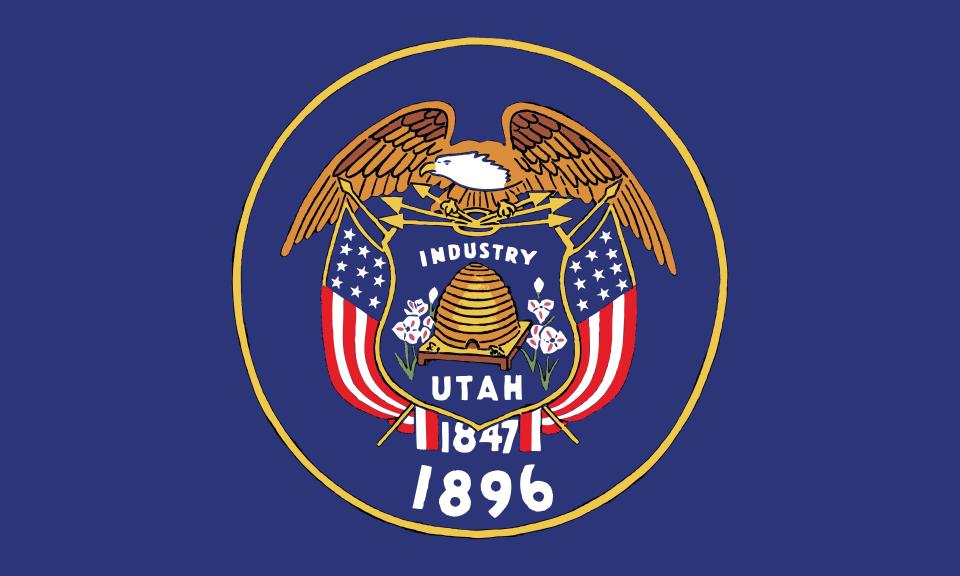
In the 1960s, another organization started promoting the Utah flag: The Salt Lake Tribune. The Tribune advertised “Flag Kits” which included an American Flag and a smaller Utah Flag.
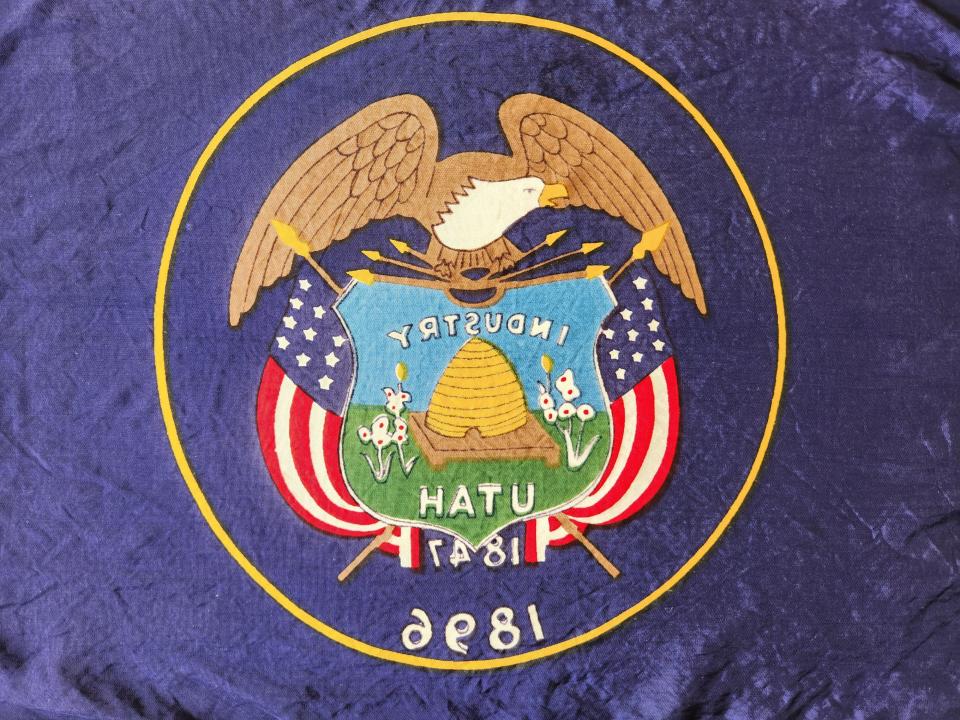
A flag contest
In 2002, the Salt Lake Tribune teamed up with the North American Vexillological Association (NAVA) for a contest to design a new state flag. Ten designs from more than 1,000 entries were chosen that would, according to NAVA, “rank among the best U.S. state flags. None of the designs inspired action by the state legislature.
The fixed flag
From the beginning, the Utah flag was open to a lot of interpretation. There were no official renditions of the flag, and the statute describing it was rather vague. Through the years, a wide variety of distorted beehives and sickly eagles found their way onto Utah flags. John Hartvigsen and Ronald Fox (one of the authors of this article) noticed the mistake made in 1922. They worked with Representative Julie Fisher to pass a joint resolution that instructed the state to correct the 89-year-old error and move the “1847” back onto the shield. A few other artistic design changes were made at the time, although these were not in the statute. The shield was returned to the white color it was in the 1913 flag. Also, the American flags now had a total of 45 stars for Utah’s spot as the 45th state. March 9 was designated as state flag day, the day the first flag law was adopted in 1911.
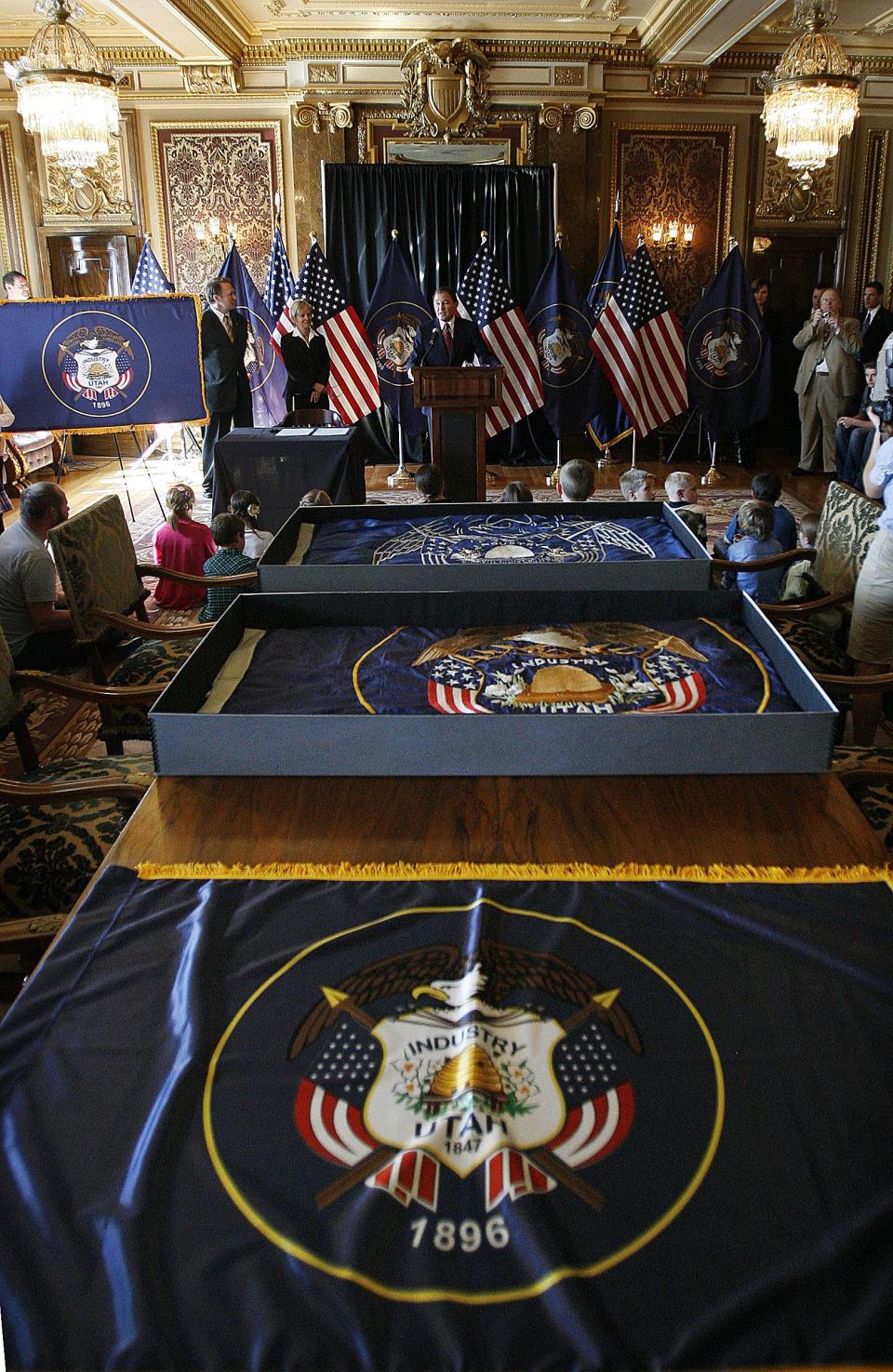
New flags for Utah
The 1927 desire of Gov. Dern to have a simpler state flag lived on. Two proposals surfaced in 2019. Rep. Steve Handy suggested a commission to review designs from the public. Rep. Keven Stratton pushed to adopt a popular design by Jonathan Martin outright. Both failed to pass.
Rep. Handy tried again in 2020, but failed.
In 2021, Rep. Handy took another tactic and partnered with Sen. Dan McCay to introduce a similar bill in the state Senate. The bill passed and created a flag task force. At the last minute, an amendment designated a new version of Martin’s 2019 flag to be the official flag of the 125th anniversary of Utah’s statehood.
Related
Cox signs bill to create new flag, issues order on how ‘historical’ flag will be flown
Do Utahns like the new state flag? A poll says more do than don’t
The Utah State Taskforce, working with several committees, and the Utah Department of Cultural and Community, conducted extensive public outreach including schoolchildren. The design subcommittee waded through 5,703 submissions, narrowing them down, combining ideas, looking for trends, and eventually coming up with a smaller slate of flags that were presented to the public for more feedback. Two of the highest ranked flags were combined into a final submission and shepherded successfully through the legislature by Sen. McCay.
The new flag featured the main symbolism of the historical flag, a beehive. It included a Utah star, a hexagon, stylized mountains symbolizing Utah’s Native Americans and a red rock valley. Gov. Spencer Cox signed the bill into law March 21, 2023. Similar to Gov. Dern’s suggestion in 1930, the historical state flag remains a state flag and, according to an executive order by Gov. Cox, takes precedence over the new state flag in some instances.
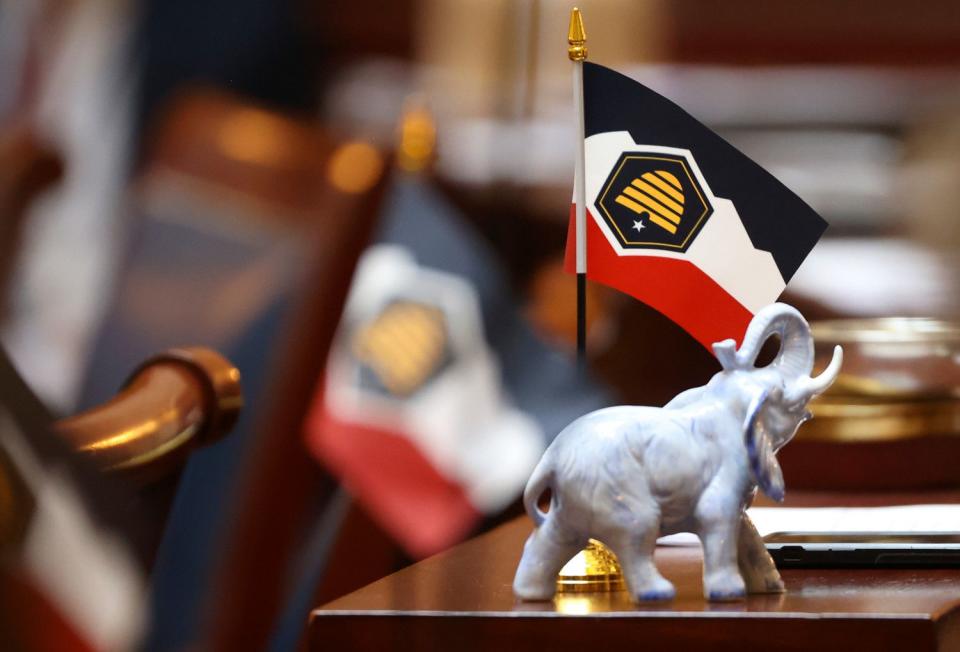
In addition to the new state flag, the statute presents a new version of the historic state flag that is based upon the beautiful 1913 flag presented to the U.S.S. Utah battleship.
Utah’s flag history is a story of change. The first flags were created without much fanfare and no public input. Over time, the love of the flag grew, in a large part due to the early efforts of the Daughters of Utah Pioneers and the Salt Lake Tribune.
But, according to a recent Deseret News poll, after 110 years, the historic Utah flag is not used by many Utahns.
Only time will tell if the new flag, created through a process that involved thousands of Utahns, will reach the popularity enjoyed by flags such as those in Texas, Arizona, Colorado and New Mexico. If not, the state’s flag history has a pattern: wait a few years and try again.

